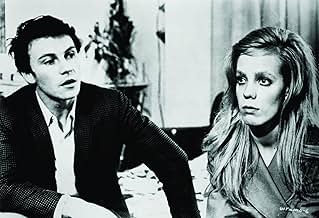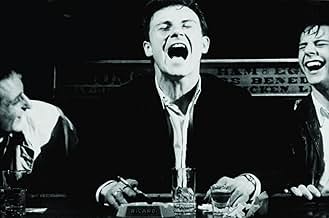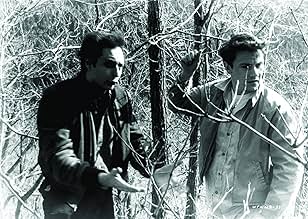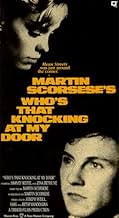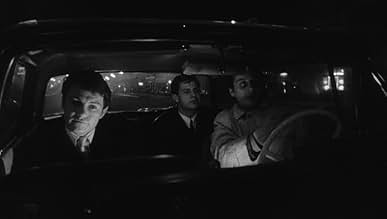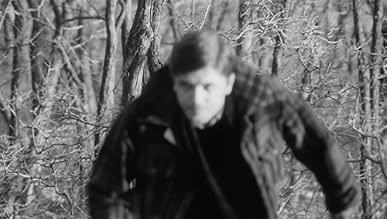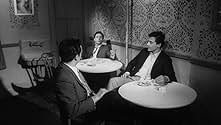ÉVALUATION IMDb
6,5/10
11 k
MA NOTE
Un jeune homme se débat avec le fait que sa petite amie a été victime d'un viol.Un jeune homme se débat avec le fait que sa petite amie a été victime d'un viol.Un jeune homme se débat avec le fait que sa petite amie a été victime d'un viol.
- Director
- Writers
- Stars
- Prix
- 1 nomination au total
Anne Collette
- Girl in Dream
- (as Ann Collette)
Philip Carlson
- Boy in Copake
- (as Phil Carlson)
Marrissa Joffre
- Girl at Party
- (as Marrisa Joffrey)
Victor Magnotta
- Boy in Fight
- (as Vic Magnotta)
Thomas Aiello
- Minor Role
- (uncredited)
Avis en vedette
"Who's That Knocking At My Door?" (1968) is the kind of film where you see it once you'll want to see it again, just to see what you didn't understand. The protagonist is played by Harvey Keitel as J.R., an autobiographical role based loosely on Scorsese's strict Catholic upbringing. And many symbolic Catholic references there are such as the Virgin Mary mini statue reflection in the mirror watching Harvey Keitel's JR as he embraces "The Young Girl" played by Zina Bethune.
Scorsese is so intelligent and inventive with his scenes here; crafty artsiness at its best (like the one where J.R. is having sex with the "broad" in a dream fantasy, but then afterwards flips his cards towards her rejecting her as a sin; she's not a nice virgin who would be a good wife and mother for J.R.; she's just a whore, a "broad", as we listen to The Doors' song 'The End' finish). Marty's own personal style was established in this early film.
Harvey Keitel was 29-years-old when Martin Scorsese's [who was 25] "Who's That Knocking At My Door?" debuted in 1968. This was a full-length feature debut for both actor Keitel and director Scorsese. It was interesting to see this for the first time recently after I had already seen most of Scorsese's later films. His classic trade marks such as the "freeze frame, slow-motion, and classic rock tracks playing on the soundtrack" are all utilized effectively in this early gem. ("Easy Rider" is always the film that is credited as being the originator of playing classic rock tunes on the soundtrack, but "Who's That Knocking At My Door?" wasn't seen by many until it received wide release in 1970, almost three years after it was made.)
For any film school student or aspiring director/screenwriter this is a must see. Mr. Scorsese financed this film on a tight budget. I read somewhere that his film professor from NYU helped him finance it. From the beginning somebody somewhere knew Marty had the talent and could make a good picture. He created a wonderful film; using his own life experience for the story he was able to concoct a great, interesting and personal film. His "Mean Streets" (1973) is a much greater and even more personal film. But "Who's That Knocking At My Door?" was the beginning.
I'm not Catholic but I certainly learn a lot about Catholicism when I watch a Scorsese flick. For instance, take the scene where "The Young Girl" is making dinner at J.R.'s place, she lights up what appears to be just a candle. But to J.R. it is a "Holy Candle" and makes her put it back and replace it with another one. There are many classic scenes in this film, but I don't want to spoil it for you.
Directed by Martin Scorsese. Edited By Thelma Schoonmaker (who would go on to edit almost all of Scorsese's later films). Starring Harvey Keitel as J.R. 90 minutes.
Scorsese is so intelligent and inventive with his scenes here; crafty artsiness at its best (like the one where J.R. is having sex with the "broad" in a dream fantasy, but then afterwards flips his cards towards her rejecting her as a sin; she's not a nice virgin who would be a good wife and mother for J.R.; she's just a whore, a "broad", as we listen to The Doors' song 'The End' finish). Marty's own personal style was established in this early film.
Harvey Keitel was 29-years-old when Martin Scorsese's [who was 25] "Who's That Knocking At My Door?" debuted in 1968. This was a full-length feature debut for both actor Keitel and director Scorsese. It was interesting to see this for the first time recently after I had already seen most of Scorsese's later films. His classic trade marks such as the "freeze frame, slow-motion, and classic rock tracks playing on the soundtrack" are all utilized effectively in this early gem. ("Easy Rider" is always the film that is credited as being the originator of playing classic rock tunes on the soundtrack, but "Who's That Knocking At My Door?" wasn't seen by many until it received wide release in 1970, almost three years after it was made.)
For any film school student or aspiring director/screenwriter this is a must see. Mr. Scorsese financed this film on a tight budget. I read somewhere that his film professor from NYU helped him finance it. From the beginning somebody somewhere knew Marty had the talent and could make a good picture. He created a wonderful film; using his own life experience for the story he was able to concoct a great, interesting and personal film. His "Mean Streets" (1973) is a much greater and even more personal film. But "Who's That Knocking At My Door?" was the beginning.
I'm not Catholic but I certainly learn a lot about Catholicism when I watch a Scorsese flick. For instance, take the scene where "The Young Girl" is making dinner at J.R.'s place, she lights up what appears to be just a candle. But to J.R. it is a "Holy Candle" and makes her put it back and replace it with another one. There are many classic scenes in this film, but I don't want to spoil it for you.
Directed by Martin Scorsese. Edited By Thelma Schoonmaker (who would go on to edit almost all of Scorsese's later films). Starring Harvey Keitel as J.R. 90 minutes.
Here is Martin Scorsese's first feature film, and already, at a mere 25 years old in 1967, it is clear this young man had the determination and eye for visceral images, solid acting and a great ear for soundtracks. A rather raw and unpolished work, Who's That Knocking at My Door works in other ways such as the professionally-done editing by the great Thelma Schoonmaker, another future Scorsese collaborator. In the lead role is a very young Harvey Keitel, who plays the role of a young New York Italian very similar to the nature and style of Martin Scorsese himself. Clearly, there was a special bond between these two that continued for years.
The plot, while at times veering wildly off track, focuses on a young couple attempting to overcome a difficult instance in the past that still looms over the future. With numerous Catholic images and references, this is one of the more explicitly religious of Scorsese's work but there is still a definitive drive behind everything. It is certainly worth watching for anyone who is interested in making their own film as well as any fan of Scorsese eager to know how he got to where he is today. Not always great, sometimes very powerful, this film still remains a strong piece of work that encompasses much of future themes Scorsese would come back to: Catholic guilt, relationships between street friends and the difficulties of romance.
The plot, while at times veering wildly off track, focuses on a young couple attempting to overcome a difficult instance in the past that still looms over the future. With numerous Catholic images and references, this is one of the more explicitly religious of Scorsese's work but there is still a definitive drive behind everything. It is certainly worth watching for anyone who is interested in making their own film as well as any fan of Scorsese eager to know how he got to where he is today. Not always great, sometimes very powerful, this film still remains a strong piece of work that encompasses much of future themes Scorsese would come back to: Catholic guilt, relationships between street friends and the difficulties of romance.
A well-dressed but feckless young man (Harvey Keitel, in his acting debut) on the streets of New York meets a lovely single girl reading a foreign magazine and strikes up a conversation about movies; soon after, they begin dating, however she volunteers more about her past than he is able to handle. Striking if aimless debut from writer-director Martin Scorsese, alternately titled "I Call First", began life as a short feature from the young film student. His sexual montage, featuring Keitel and his 'broads' (and set to "The End" by the Doors), is a fabulous example of cinematic sound and fury: the perfect marriage between silvery black-and-white cinematography, kinetic editing, great music and lusty bodies. Unfortunately, Scorsese as a writer had not developed a true ear for canny dialogue, and the characters fail to emerge as a result. Still, an almost-dynamic first try, and a must-see for film historians. Keitel, marvelously youthful and muscular, is more callow than expressive, though he gives the picture its pulse; the cinematography from Richard Coll and Michael Wadley is a major asset as well. **1/2 from ****
Filmed over years apparently, this early M. Scorsese New York tale involving young dudes being typically out of it is interesting in the scenes with Keitel and the girl (Z. Bethune), but the buddy scenes tend to drag on and semi-bore. A 5 out of 10. Best performance = Zena Bethune.
Harvey Keitel has always been interesting and believable and it's great to see him in a lead (pre-MEAN STREETS) and Ms. Bethune is very touching and human. All Scorsese fans should track this down even though it's not that great. The DVD has a semi-commentary from Marty which is unusual! It comes in the recent DVD set of Martin Scorsese and worth a look! Harry Northrup has a small role (MEAN STREETS, TAXI DRIVER).
Harvey Keitel has always been interesting and believable and it's great to see him in a lead (pre-MEAN STREETS) and Ms. Bethune is very touching and human. All Scorsese fans should track this down even though it's not that great. The DVD has a semi-commentary from Marty which is unusual! It comes in the recent DVD set of Martin Scorsese and worth a look! Harry Northrup has a small role (MEAN STREETS, TAXI DRIVER).
a definite must for all scorsese fans. runs much like a student film. Use of music is still very ruff in this film. Not nearly as effective as in mean streets. Many of the same ideas scorsese will later work out in mean streets. Harvey Keitel's performance is powerful. Filmed mostly on Elizabeth St where scorsese grew up and his childhood apartment. highly recommended
What Scorsese Film Ranks Highest on IMDb?
What Scorsese Film Ranks Highest on IMDb?
Cinema legend Martin Scorsese has directed some of the most acclaimed films of all time. See how IMDb users rank all of his feature films as director.
Le saviez-vous
- AnecdotesIn order to get distribution for his film, Martin Scorsese was told to add nude scenes so it could be promoted as a "sexploitation" movie. He thus shot the fantasy scene showing J.R. imagining encounters with prostitutes.
- GaffesMartin Scorsese utilizes the black and white nature of film to hide the lack of time and day continuity in some scenes.
- Générique farfeluThere is a big "Thanks to the County and City of New York" in the end credits.
- Autres versionsEarly versions of this film were screened without the erotic fantasy scene.
- ConnexionsFeatured in A Decade Under the Influence (2003)
- Bandes originalesJenny Take a Ride
(uncredited)
Written by Bob Crewe, Enotris Johnson, and Little Richard
Performed by Mitch Ryder & The Detroit Wheels
Meilleurs choix
Connectez-vous pour évaluer et surveiller les recommandations personnalisées
Détails
- Date de sortie
- Pays d’origine
- Sites officiels
- Langue
- Aussi connu sous le nom de
- Who's That Knocking at My Door
- Lieux de tournage
- Amsterdam, Noord-Holland, Pays-Bas(as New York, only interior, scenes with nudity)
- sociétés de production
- Consultez plus de crédits d'entreprise sur IMDbPro
Box-office
- Budget
- 75 000 $ US (estimation)
- Brut – à l'échelle mondiale
- 16 085 $ US
- Durée1 heure 30 minutes
- Couleur
- Mixage
- Rapport de forme
- 1.85 : 1
Contribuer à cette page
Suggérer une modification ou ajouter du contenu manquant

Lacune principale
By what name was I Call First (1967) officially released in India in Hindi?
Répondre
